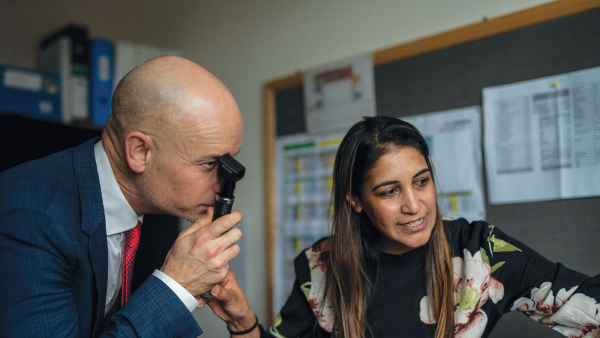At-Home Glaucoma Monitoring
Stanford University research uncovers correlation between in-clinic measurements and at-home testing for glaucoma monitoring
Patient telemonitoring was already making significant headway in ophthalmology in the days before COVID-19. Its progress was further accelerated by the pandemic, answering the need for “face-to-face” meetings requiring no bodily contact and no risk of infection, and creating what some referred to as a “tsunami of teleophthalmology.”
But how does teleophthalmology contribute towards glaucoma screening and the long-term monitoring of the disease?
In a study of 15 glaucoma patients, researchers at Stanford assessed the validity, repeatability, and feasibility of such remote glaucoma monitoring devices, looking specifically at the Olleyes VisuALL Virtual Reality Platform (VRP), a head-mounted visual field test and the iCare Home tonometer. The study’s aim was to assess whether home-based tests could provide reliable data comparable to in-clinic tests.
The 15 patients – nine of whom successfully completed the study – were instructed to self-test over three consecutive days, using the VRP field test once per day and taking IOP measurements using the iCare Home four times per day. The results from the home tests were compared with in-clinic measurements taken using a Goldmann applanation tonometer (GAT) and an in-clinic Humphrey Field Analyzer (HFA) visual field test that was taken on the day of device training.
“Most of the patients were motivated enough to perform both visual field and iCare Home tonometry with just one training session and without reminders or incentives,” says Ann Shue, corresponding study author from the Department of Ophthalmology, Stanford University School of Medicine, adding that this “willingness persisted throughout the study.”
In terms of ease of use, it was reported that 40 percent of participants found it challenging to use the iCare HOME device, particularly when positioning it on the eye. The device does need precise placement to capture reliable measurements, Shue notes, and this can sometimes be “harder for some older patients and those with advanced visual field loss,” as well as “making adjustments to fix poor readings based on the error beeps.”
However, there was still a strong correlation between the in-clinic measurements and those taken at home. Visual field measurements from the VRP closely matched those from the single in-clinic HFA test, with an 87.9 percent correlation; in addition, the home tonometry tests captured higher peak IOP values than those recorded in the clinic, indicating that at-home testing could have the potential to detect IOP spikes missed during scheduled clinic visits.
The authors also believe that as patients are able to determine the optimal timing of their glaucoma medication regimen based on the multiple IOP measurements they take each day, this proactive approach to their own health – and the tailored feedback given by the device – helps to further improve adherence.
While further research with larger cohorts is needed to validate their findings, the researchers conclude that, given “the increasing affordability, ease of use, and portability of [at-home devices]... it is likely that they will become more widely used in glaucoma management.”
They are now interested in “longer term home monitoring over months to years” to accurately gauge how glaucoma management might be impacted when patients are comparing their home data alongside in-office data. “The main value,” adds Shue, “is whether the additional data may change therapy patterns and save more vision compared to [the] current standard of care.”
The New Optometrist Newsletter
Permission Statement
By opting-in, you agree to receive email communications from The New Optometrist. You will stay up-to-date with optometry content, news, events and sponsors information.
You can view our privacy policy here
Most Popular
Sign up to The New Optometrist Updates
Permission Statement
By opting-in, you agree to receive email communications from The New Optometrist. You will stay up-to-date with optometry content, news, events and sponsors information.
You can view our privacy policy here
Sign up to The New Optometrist Updates
Permission Statement
By opting-in, you agree to receive email communications from The New Optometrist. You will stay up-to-date with optometry content, news, events and sponsors information.
You can view our privacy policy here







